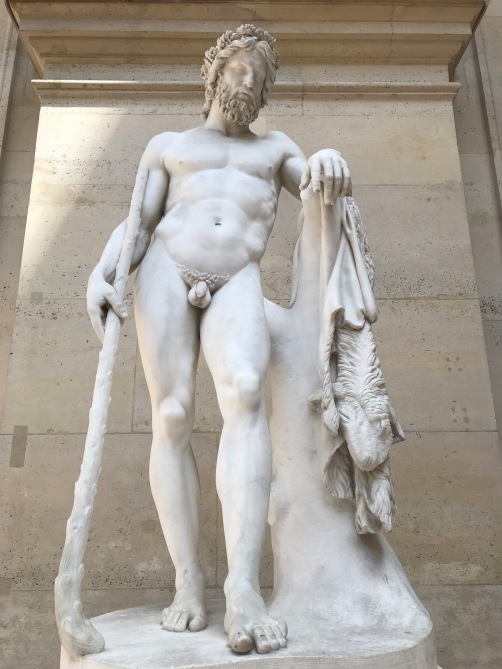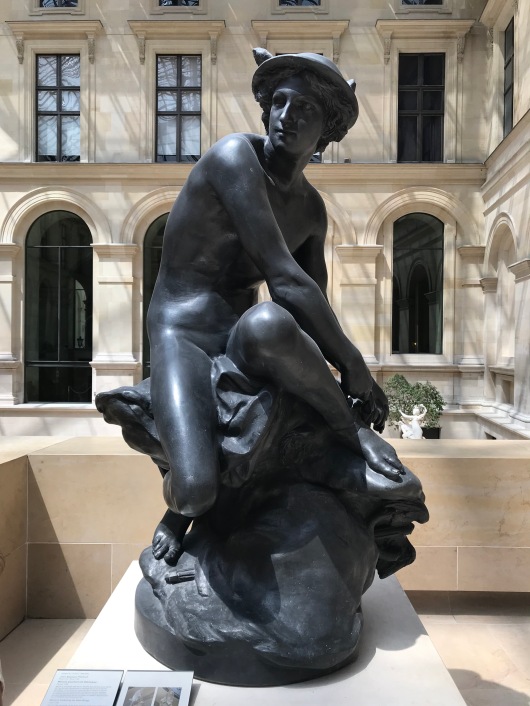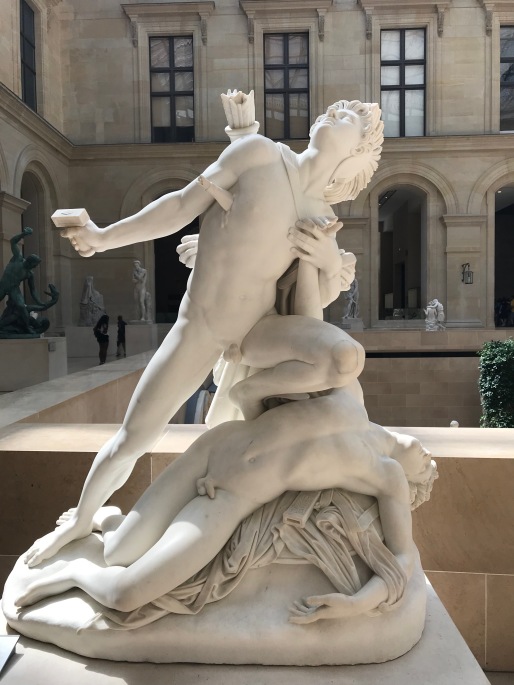What spirit is so empty and blind, that it cannot recognize the fact that the foot is more noble than the shoe, and skin more beautiful than the garment with which it is clothed?

I have scoured the Internet, talking it over with many naturist readers, but I have yet to find heroes quite like Xandr and Thelana. As far as I can tell, they are unique to the fantasy genre, in that they are the first heroes in modern times wherein their bare bodies are their costumes. Some readers will suggest Robert Heinlein, Isaac Asimov or Edgar Rice Burroughs, all of whom dabbled with nudity or naturist philosophy in their writings, to a limited degree. Without question, the Martian in Heinlein’s Stranger in a Strange Land often prefers going nude, but he is also an alien, and too removed from humanity to be relatable, going so far as to consider cannibalism proper etiquette. Burroughs, while describing both Tarzan and John Carter in the buff in his books, devotes very little time to naturist philosophy. In Carter, the nudity is incidental and inconsequential to the plot, a matter of titillation for adolescent boys in an age before Internet porn. This isn’t to dismiss the number of genuine naturist novels written by and for naturists, but those stories typically do not fall into the fantasy genre, and too often the characters serve as two dimensional archetypes, mannequins that parrot the author’s beliefs. Despite my passion for nudism, Ages of Aenya is first and foremost an adventure novel, written for lovers of The Lord of the Rings, Game of Thrones, and all things fantasy.
Now a reader might question, and I have often put this to myself, why does it matter? Couldn’t Xandr and Thelana be just as heroic without their genitals dangling? What makes being naked so special? And what is it with my preoccupation/obsession with the human form? The answer can be summed up in three words: the heroic nude.

The heroic nude is largely forgotten in our culture. Any modern representation of a naked man or woman, in art or in fiction, is almost always intended for sexual stimulation. But this wasn’t always the case. The notion that simple nudity must always equate to pornography is a myth, propagated by corporations who manipulate our sense of arousal to sell their products. What’s more, the myth must be continually reinforced by increasingly sexualized imagery. Putting a bare body on display these days is no longer enough. Try Googling “nude” or “naked” and you will inevitably find every kind of erotic pose, extreme close ups of genitals, grotesque distortions of human anatomy, or just flat out depictions of intercourse. You rarely see the human body as it is, in its simplest form, which is precisely why so many people find it difficult to view nudity in an honest and realistic way. When I look for artists to portray my heroes, I have a hard time explaining to them what I want to see. The average American does not accept nudity for non-sexual reasons, which is why, too often, the artists I solicit think I am asking for porn, and if they have moral objections to porn, they turn me down. It is no wonder that, after ten years of searching, the three artists I now work with live outside the country, in Brazil, Italy, and in the Ukraine. Having studied art history, they understand what the heroic nude is and why it matters.

What is important to understand about the heroic nude is context. For most of the Classical and Renaissance periods, which encompassed Greece and later most of Europe, the people of those times did not literally conceive of their heroes as nudists per se. Homer goes to great lengths, in fact, to describe Achilles’ armor, and Heracles often wore a lion’s mane. But what mattered to the Europeans of antiquity was the human ideal expressed through nudity. Michelangelo’s David, for instance, is more than a character from Hebrew scripture; he is man in his highest and most idealized form. For the Ancient Greeks especially, the human form was the apex of natural design, the highest expression of art, utterly divine. This is an important distinction, because it set the Greeks apart from the rest of the world. At roughly the same time period, you would find, in Egypt, gods with the bodies of animals, Ra with a hawk head, Anubis as a dog, and Bast as a cat.

In India, the Hindus worshipped Shiva, with her many arms and blue skin, and Brahma with his three faces, and Ganesha, whose head resembles that of an elephant. Other cultures were even more extreme in their conceptions of a supreme being. For the Hebrews, god was and is invisible and unknowable. The deity of the Aztecs, Quetzalcoatl, was a feathered serpent. Only the Olympian gods appeared human, and not just human, but man in his most simple state of being. You can easily identify Aphrodite, goddess of love, in any museum, since she never wears any clothes.

Zeus, Poseidon, Apollo, Hermes and Artemis also appear, in sculpture and in paint, with the bodies of superheroes, but unlike Superman and Batman, they didn’t need skintight clothing to show off their muscular physiques. For the Greeks, the gods did not exist in some lofty, inconceivable realm, nor look down upon mankind with indifference, contempt or judgment. Man was not born into sin. Nor was he, as the Vikings portrayed, the product of giant sweat. In fact, Zeus found mortal women irresistible, frequently descending from his abode on Mount Olympus looking for a hook up. The Greek heroes, among them Heracles, Achilles and Theseus, were the progeny of the gods and served as bridges between man and deity, long before the Bible copied the idea. However, far from the semi-nude fantasy protagonists of today, like Conan or Tarzan, or so many other generic barbarian-types adorning book and video game covers with their minimal loincloths, Classical and Renaissance creators did not feel the need to hide their heroes’ genitals from the public eye.

In depicting divine and semi-divine beings with every human attribute, with muscles, bones, veins, and even genitalia, god and man became inseparable in the minds of the ancient Greeks and Romans, which had a profoundly positive effect in how they perceived themselves. Like the gods, man could be inventive, could be made to rise above his meager roots to the heights of his imagination. Is it any wonder that Daedalus, father of Icarus, managed to fashion wings out of wax and feathers to fly? Sure, it’s only a story, but what hero from the Bible ever displayed such ingenuity? This positive outlook gave rise to history, geometry, drama, philosophy, and yes, democracy. The Greeks helped to elevate humanity, from lowly creatures groveling before god-kings, to divine beings with reason and individuality. Without the Classical world, our modern society would not exist as it is today. We could never have dreamt of going to the moon much less stepped foot on it. And the heroic nude is a big part of that achievement. With Hermes, a masterpiece borne of marble by the hands of Praxiteles circa the 4th century BC, the heroic ideal is made manifest, the highest of man’s aspirations, man made larger than life, inspiring, divine.

So what happened? In a word, Christianity. The collapse of the Roman Empire was followed by centuries of disease, warfare and poverty. During these dark ages, it was easy for Europeans to reject the world of the senses, and, taking cues from Plato and Judaism, early Christians focused their sights on the heavenly kingdom, and on the world of the spirit. Unlike Zeus, the Hebrew god YHWH did not physically mate with Mary of Nazareth, conceiving without sex, for the physical body was relegated to an “earthly” vessel, to be discarded in the afterlife. Nor could humanity, in his sinful bodily form, ever hope to achieve divinity. Instead, man became a shameful creature, born into sin and destined for the fires of Hell. Only by God’s grace could he hope to be saved. Anything of the material world, whether it be food or sex, was of the Devil, which is why so many monks lived in seclusion, away from women, often castrating themselves to overcome their carnal thoughts. Countless pagan religions, for whom communal nudity was used for both ritual and celebration, became “demonized,” and their practitioners, deemed witches by the new, conservative faith, were tortured and burned. At the height of the Christian world, the heroic nude was abandoned, and the human body became a thing of evil, of temptation, to be rejected if possible.

Flash forward a thousand years, to the sexual revolution of the 1960’s and 70’s, and we find a counterculture rebelling against Church doctrine. But while many people become sexually “liberated,” attitudes toward the human body, deeply entrenched for centuries, do not wash away. American society, founded, in part, by a Christian Puritan cult, remains deeply divided. It is a country with a billion dollar XXX film industry, that delays all live broadcasts for seven seconds lest a performer accidentally reveal a nipple. With the advent of the Internet, these divisions run deeper. Graphic and unnatural depictions of sex, things that would shock even the most depraved Greeks and Romans, now exist at the fingertips of any man, woman or child, and yet Facebook censors a woman breast feeding. A perfect storm of deeply rooted Platonic/Christian beliefs and an equally powerful counterculture has resulted in our current schizophrenic state, and what we have forgotten in all this, is how to look at ourselves, and see human beings.

We have forgotten that our bodies are good things, that nakedness was the ideal. Through my fiction and in my art, I have tried to revive this age old tradition, to bring about a new Renaissance, which is why Xandr and Thelana, as modern vestiges of the heroic nude, are so compelling to me. Their costumes are their bodies, because they are descendants of Apollo and Aphrodite, of gods and heroes that helped lift our thinking out of our prehistoric and superstitious beginnings. Xandr and Thelana carry the Olympic torch of heroic nudity so that we might see within ourselves something divine.

Actually it's Michael-Angel's David, not Leonardo's.
But otherwise, excellent post!
LikeLike
I agree that Co-ed Naked Philosophy fails as fiction. That's a shame, because the textile world will not read it. Nudies will read it because of the title, but that's preaching to the choir.
LikeLike
Nick i do agree with you about a ideal of going to become a Naturism may help us human evolved into more this Perfect Pacifist beings that will being Peace no shame no fear no more killing no more porn but with still going some technology robot will more like a pet not a killer because that is really a impossible for robot do that thing in real life and in the the real world future for mankind.
LikeLike
Tarzan was also very influential in shaping my attitudes about nudity, outdoors in particular. In the Elmo Lincoln silent film, the young Tarzan is portrayed naked.
LikeLike
Really? That is very interesting. I sometimes feel that I am the reincarnation of Edgar Rice Burroughs; we share so many similar beliefs and passions and he died before I was born so who knows? I talk a lot about Tarzan in my other naturist posts.
LikeLike
Reblogged this on the Writer's Disease and commented:
After my visit to the Louvre this year, I knew I had to revisit my old article, which I wrote in 2013, in which I discuss the ‘heroic nude,’ why it is important, and how it has inspired me and my writing.
LikeLike
As a Christian, there’s a couple of points I would like to make:
– The Hebrew God is not undepicted because he is some unknowable inhuman god, but because he specifically asked us to not depict him and according to the part of the bible we share, we were made as copies of him making God the original, perfect, human form.
– A reasonable part of the Christian anti-nudist mentality is something that was added on at a later date. The Old Testament has many examples of godly people being nude, even in public, just because they were happy, and while I don’t know of any explicit New Testament examples, there is evidence to suggest that at least some of the 12 disciples (the ones that fished) worked nude.
LikeLiked by 1 person
If we were to judge by early Christian iconography, when compared to Classical and Renaissance art, the human body is rarely represented in a positive light. I do agree, however, that many passages from the Bible can be interpreted to suggest that Christianity is favorable to nudism, and I have met a number of Christian nudists in real life. Both Isaiah and John the Baptist had a propensity for public nakedness, as did possibly Jeremiah. There was also the Russian sect, the Adamites, who believed it God’s will that mankind return to a state of nakedness. That being said, nude women in the Bible are nearly nonexistent. Or they are portrayed negatively, as in the story of Bathsheba, whose nudity served to tempt David. There really is no equivalent to Artemis or Aphrodite in Christianity.
LikeLike
The most obvious example of biblical nudity is of course Adam and Eve, showing that the perfect, pure, sinless state of humanity is nude men and women, so I guess that’s one positive nude female role-model in the bible…
Also, I tend to try to ignore Christian iconography due to its blatant inaccuracy – as an example, the classic image of the Crucifixion: White, clean, unblemished skin with no hair below the neck, a clean white loincloth, a little bit of artful blood from the nails and crown of thorns, and a look of calm sadness on his face. The Jewish complexion of the time was probably olive-skined, he’d been in custody at least one night, during which time he had been whipped, then given the crown of thorns before being spat upon and beaten over the head. And while Jewish law didn’t prohibit general shaving (I learnt something new today – it was only certain parts of the beard) I strongly doubt a man that spent most of his time on the road would have had time to keep his body clear of hair. Then of course, there’s the fact that crucifixion was also supposed to be a humiliation, and the romans tended to nail them up naked, and we literally get the word “excruciating” from crucifixion, ruining any chance of his expression being accurate.
LikeLiked by 1 person
Adam and Eve were indeed naked and without shame, but the narrative suggests that after eating of the Fruit of Knowledge of Good and Evil, they recognized their nakedness and quickly donned clothing. This narrative suggests that even though God intended for us to be nude, Original Sin made it so that such an ideal was no longer possible. Of course, this narrative falls apart when we consider other cultures beyond Hebrew and Mesopotamian civilizations (most of which were desert dwelling and nomadic), who had no problem with communal nakedness, like the Greeks, Celts and Amazonian tribes. The concept of naked shame didn’t even exist until the Adam and Eve story was pushed on those societies by Christian missionaries.
As for Christian iconography, I was referring more to medieval Byzantine depictions of the Apostles, Saints, and Mary, mother of Jesus. Nobody looks happy in these paintings. They are all depressed, emaciated, and off-color. If you were to ask me whether I would wish to look like an early depiction of Saint Peter, or like Hermes by Praxiteles, you know I’ll take Hermes any day.
LikeLike